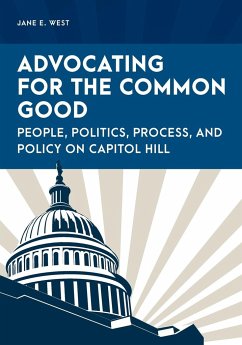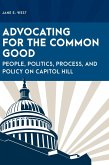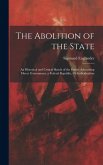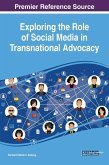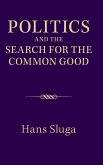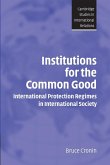- Broschiertes Buch
- Merkliste
- Auf die Merkliste
- Bewerten Bewerten
- Teilen
- Produkt teilen
- Produkterinnerung
- Produkterinnerung
Drawing on both the public policy scholarship and the daily practicalities on Capitol Hill, this book builds on the author's extensive federal policy experience as well as that of others to offer the information and tools needed to effectively participate in Washington D.C. policy-making. Rich and accessible, this book is a clear call for action.
Andere Kunden interessierten sich auch für
![Advocating for the Common Good Advocating for the Common Good]() Jane E. WestAdvocating for the Common Good106,99 €
Jane E. WestAdvocating for the Common Good106,99 €![The Abolition of the State: An Historical and Critical Sketch of the Parties Advocating Direct Government, a Federal Republic, Or Individualism The Abolition of the State: An Historical and Critical Sketch of the Parties Advocating Direct Government, a Federal Republic, Or Individualism]() Sigmund EngländerThe Abolition of the State: An Historical and Critical Sketch of the Parties Advocating Direct Government, a Federal Republic, Or Individualism35,99 €
Sigmund EngländerThe Abolition of the State: An Historical and Critical Sketch of the Parties Advocating Direct Government, a Federal Republic, Or Individualism35,99 €![Exploring the Role of Social Media in Transnational Advocacy Exploring the Role of Social Media in Transnational Advocacy]() Exploring the Role of Social Media in Transnational Advocacy204,99 €
Exploring the Role of Social Media in Transnational Advocacy204,99 €![Reenvisioning Peacebuilding and Conflict Resolution in Islam Reenvisioning Peacebuilding and Conflict Resolution in Islam]() Qamar-Ul HudaReenvisioning Peacebuilding and Conflict Resolution in Islam118,99 €
Qamar-Ul HudaReenvisioning Peacebuilding and Conflict Resolution in Islam118,99 €![Reenvisioning Peacebuilding and Conflict Resolution in Islam Reenvisioning Peacebuilding and Conflict Resolution in Islam]() Qamar Ul-HudaReenvisioning Peacebuilding and Conflict Resolution in Islam51,99 €
Qamar Ul-HudaReenvisioning Peacebuilding and Conflict Resolution in Islam51,99 €![Politics and the Search for the Common Good Politics and the Search for the Common Good]() Hans SlugaPolitics and the Search for the Common Good100,99 €
Hans SlugaPolitics and the Search for the Common Good100,99 €![Institutions for the Common Good Institutions for the Common Good]() Bruce CroninInstitutions for the Common Good27,99 €
Bruce CroninInstitutions for the Common Good27,99 €-
-
-
Drawing on both the public policy scholarship and the daily practicalities on Capitol Hill, this book builds on the author's extensive federal policy experience as well as that of others to offer the information and tools needed to effectively participate in Washington D.C. policy-making. Rich and accessible, this book is a clear call for action.
Hinweis: Dieser Artikel kann nur an eine deutsche Lieferadresse ausgeliefert werden.
Hinweis: Dieser Artikel kann nur an eine deutsche Lieferadresse ausgeliefert werden.
Produktdetails
- Produktdetails
- Verlag: Rowman & Littlefield Publishers
- Seitenzahl: 198
- Erscheinungstermin: 17. Mai 2023
- Englisch
- Abmessung: 254mm x 178mm x 11mm
- Gewicht: 384g
- ISBN-13: 9781538155233
- ISBN-10: 1538155230
- Artikelnr.: 67185246
- Herstellerkennzeichnung
- Libri GmbH
- Europaallee 1
- 36244 Bad Hersfeld
- gpsr@libri.de
- Verlag: Rowman & Littlefield Publishers
- Seitenzahl: 198
- Erscheinungstermin: 17. Mai 2023
- Englisch
- Abmessung: 254mm x 178mm x 11mm
- Gewicht: 384g
- ISBN-13: 9781538155233
- ISBN-10: 1538155230
- Artikelnr.: 67185246
- Herstellerkennzeichnung
- Libri GmbH
- Europaallee 1
- 36244 Bad Hersfeld
- gpsr@libri.de
By Jane E. West
Acknowledgments
Author's Note
Introduction
Chapter 1: People
The Iron Triangle
1. Congress
* Congressional Staff and Congressional Committees
* Relationships Are Everything
2. The Executive Branch
3. Interest Groups
* Professional and Trade Associations
* Business or Corporation Associations
* Public Interest Groups
* Think Tanks
* What Do Interest Groups Do in Relation to Policy and Advocacy?
* Political Action Committees and 501 (c) (4)'s
* Coalitions
* Government Relations/Lobbying Firms
* Lobbying
Beyond the Iron Triangle
* The Courts
* Social Media and the Press
* Public Opinion
* Constituents
* Grass Roots Movements and Organizations
* Experts
The Culture of Policy Making vs. the Cultures of Other Sectors
Representation Matters
Take Aways: The People
References
Chapter 2: Politics
Majorities and Minorities in Congress
* Seniority in Congress
The White House
Election Cycles
Participating in Election Campaigns
Transitions after Winning an Election
Bipartisanship
Tale Aways: The Politics
References
Chapter 3: Process
Part I: Summary of the Literature on Public Policy Making Processes
4. Framework #1: the Cyclical Framework
* Problem Definition
* Agenda Setting
* Policy Formulation
* Policy Adoption
* Policy Implementation
* Policy Evaluation
5. Framework #2: Policy Streams
Part II: Congressional Procedures
6. How a Bill Becomes a Law: The Seven Steps of Regular Order
* Bill Introduction
* The Committee Receives the Bill
* Possible Referral to Subcommittee
* Hearings and Markups
* Floor Consideration
* Conference Committee
* President's Signature
7. Three Core Legislative Processes: Budget, Appropriations, Authorization
8. Budget Process
* Reconciliation
* Deeming Resolutions
9. Appropriations Process
* Mandatory and Discretionary Spending
* Earmarks
10. Authorization Process
11. Other Congressional Processes
* Oversight and Investigations
* Confirmations
12. Senate and House Rules
* Committee on Rules of the House of Representatives
* Filibuster and Cloture in the Senate
Part 3: Executive Branch Processes
13. Executive Orders
14. Federal Rulemaking
* Before the Proposed Rule
* The Proposed Rule
* Before the Final Rule
* The Final Rule
* After the Final Rule
15. Negotiated Rulemaking
16. Other Key Federal Agency Functions Related to Policy Making
* Guidance
Take-Aways: The Processes
References
Chapter 4: Policy
Which Comes First: The Problem or the Solution?
Policy Tools
* Grants
* Appropriations
* Civil Rights
* Accountability
* Data Collection
* Enforcement Mechanisms
* Research
* Individual Benefits
* Tax Code
* Requirements Related to Implementation by Federal Agency
What is Good Policy?
17. The Americans with Disabilities Act and the Use of Standardized Assessment
in Federal Education Policy: Point/Counterpoint
18. The ADA: A Remarkable Policy
19. NCLB and Its Derivatives: The Use of Standardized Assessments in Federal
Education Policy A Cautionary Tale
* Race to the Top 2009
* Teacher Preparation Regulations 2011-2017
20. Lessons Learned
Take Aways: The Policy
Chapter 5: Advocacy: Putting It All Together
Advocating with Congressional Offices
* First and Foremost: Build a Relationship
* Prepare for Meetings
* Provide Background Information, Data, Stories
* Refine Your Message so it Will Be Heard by Your Audience
* Be Prepared with No More than Three "ASKS"
* Offer Invitations to Speak or Visit
* Don't Get Mad or Argue or Talk Politics
* Always Follow Up
* Keep Showing Up
* Add Your Voice to a National Organization
Advocating with the Executive Branch
Artifacts for Advocacy
* Committee and Subcommittee Activities: Hearings, Markups, and More
* Other Statements from Members of Congress
* Status of Bills Introduced
* Reports from the Congressional Research Service
* Documents from the Government Accountability Office
* Developments from the White House and Federal Agencies
Connecting Research, Practice, and Policy
Participating in a Committee Hearing or a Town Hall Meeting
Impact of the COVID-19 Pandemic on Advocacy Activities
Impact of January 6, 2021 Events at the Capitol on Security Measures
In Closing
Take Aways: Advocacy
Chapter 6: Wrapping Up: Being at the Table... Not on the Menu
References
Index
About the Interviewees
About the Author
Author's Note
Introduction
Chapter 1: People
The Iron Triangle
1. Congress
* Congressional Staff and Congressional Committees
* Relationships Are Everything
2. The Executive Branch
3. Interest Groups
* Professional and Trade Associations
* Business or Corporation Associations
* Public Interest Groups
* Think Tanks
* What Do Interest Groups Do in Relation to Policy and Advocacy?
* Political Action Committees and 501 (c) (4)'s
* Coalitions
* Government Relations/Lobbying Firms
* Lobbying
Beyond the Iron Triangle
* The Courts
* Social Media and the Press
* Public Opinion
* Constituents
* Grass Roots Movements and Organizations
* Experts
The Culture of Policy Making vs. the Cultures of Other Sectors
Representation Matters
Take Aways: The People
References
Chapter 2: Politics
Majorities and Minorities in Congress
* Seniority in Congress
The White House
Election Cycles
Participating in Election Campaigns
Transitions after Winning an Election
Bipartisanship
Tale Aways: The Politics
References
Chapter 3: Process
Part I: Summary of the Literature on Public Policy Making Processes
4. Framework #1: the Cyclical Framework
* Problem Definition
* Agenda Setting
* Policy Formulation
* Policy Adoption
* Policy Implementation
* Policy Evaluation
5. Framework #2: Policy Streams
Part II: Congressional Procedures
6. How a Bill Becomes a Law: The Seven Steps of Regular Order
* Bill Introduction
* The Committee Receives the Bill
* Possible Referral to Subcommittee
* Hearings and Markups
* Floor Consideration
* Conference Committee
* President's Signature
7. Three Core Legislative Processes: Budget, Appropriations, Authorization
8. Budget Process
* Reconciliation
* Deeming Resolutions
9. Appropriations Process
* Mandatory and Discretionary Spending
* Earmarks
10. Authorization Process
11. Other Congressional Processes
* Oversight and Investigations
* Confirmations
12. Senate and House Rules
* Committee on Rules of the House of Representatives
* Filibuster and Cloture in the Senate
Part 3: Executive Branch Processes
13. Executive Orders
14. Federal Rulemaking
* Before the Proposed Rule
* The Proposed Rule
* Before the Final Rule
* The Final Rule
* After the Final Rule
15. Negotiated Rulemaking
16. Other Key Federal Agency Functions Related to Policy Making
* Guidance
Take-Aways: The Processes
References
Chapter 4: Policy
Which Comes First: The Problem or the Solution?
Policy Tools
* Grants
* Appropriations
* Civil Rights
* Accountability
* Data Collection
* Enforcement Mechanisms
* Research
* Individual Benefits
* Tax Code
* Requirements Related to Implementation by Federal Agency
What is Good Policy?
17. The Americans with Disabilities Act and the Use of Standardized Assessment
in Federal Education Policy: Point/Counterpoint
18. The ADA: A Remarkable Policy
19. NCLB and Its Derivatives: The Use of Standardized Assessments in Federal
Education Policy A Cautionary Tale
* Race to the Top 2009
* Teacher Preparation Regulations 2011-2017
20. Lessons Learned
Take Aways: The Policy
Chapter 5: Advocacy: Putting It All Together
Advocating with Congressional Offices
* First and Foremost: Build a Relationship
* Prepare for Meetings
* Provide Background Information, Data, Stories
* Refine Your Message so it Will Be Heard by Your Audience
* Be Prepared with No More than Three "ASKS"
* Offer Invitations to Speak or Visit
* Don't Get Mad or Argue or Talk Politics
* Always Follow Up
* Keep Showing Up
* Add Your Voice to a National Organization
Advocating with the Executive Branch
Artifacts for Advocacy
* Committee and Subcommittee Activities: Hearings, Markups, and More
* Other Statements from Members of Congress
* Status of Bills Introduced
* Reports from the Congressional Research Service
* Documents from the Government Accountability Office
* Developments from the White House and Federal Agencies
Connecting Research, Practice, and Policy
Participating in a Committee Hearing or a Town Hall Meeting
Impact of the COVID-19 Pandemic on Advocacy Activities
Impact of January 6, 2021 Events at the Capitol on Security Measures
In Closing
Take Aways: Advocacy
Chapter 6: Wrapping Up: Being at the Table... Not on the Menu
References
Index
About the Interviewees
About the Author
Acknowledgments
Author's Note
Introduction
Chapter 1: People
The Iron Triangle
1. Congress
* Congressional Staff and Congressional Committees
* Relationships Are Everything
2. The Executive Branch
3. Interest Groups
* Professional and Trade Associations
* Business or Corporation Associations
* Public Interest Groups
* Think Tanks
* What Do Interest Groups Do in Relation to Policy and Advocacy?
* Political Action Committees and 501 (c) (4)'s
* Coalitions
* Government Relations/Lobbying Firms
* Lobbying
Beyond the Iron Triangle
* The Courts
* Social Media and the Press
* Public Opinion
* Constituents
* Grass Roots Movements and Organizations
* Experts
The Culture of Policy Making vs. the Cultures of Other Sectors
Representation Matters
Take Aways: The People
References
Chapter 2: Politics
Majorities and Minorities in Congress
* Seniority in Congress
The White House
Election Cycles
Participating in Election Campaigns
Transitions after Winning an Election
Bipartisanship
Tale Aways: The Politics
References
Chapter 3: Process
Part I: Summary of the Literature on Public Policy Making Processes
4. Framework #1: the Cyclical Framework
* Problem Definition
* Agenda Setting
* Policy Formulation
* Policy Adoption
* Policy Implementation
* Policy Evaluation
5. Framework #2: Policy Streams
Part II: Congressional Procedures
6. How a Bill Becomes a Law: The Seven Steps of Regular Order
* Bill Introduction
* The Committee Receives the Bill
* Possible Referral to Subcommittee
* Hearings and Markups
* Floor Consideration
* Conference Committee
* President's Signature
7. Three Core Legislative Processes: Budget, Appropriations, Authorization
8. Budget Process
* Reconciliation
* Deeming Resolutions
9. Appropriations Process
* Mandatory and Discretionary Spending
* Earmarks
10. Authorization Process
11. Other Congressional Processes
* Oversight and Investigations
* Confirmations
12. Senate and House Rules
* Committee on Rules of the House of Representatives
* Filibuster and Cloture in the Senate
Part 3: Executive Branch Processes
13. Executive Orders
14. Federal Rulemaking
* Before the Proposed Rule
* The Proposed Rule
* Before the Final Rule
* The Final Rule
* After the Final Rule
15. Negotiated Rulemaking
16. Other Key Federal Agency Functions Related to Policy Making
* Guidance
Take-Aways: The Processes
References
Chapter 4: Policy
Which Comes First: The Problem or the Solution?
Policy Tools
* Grants
* Appropriations
* Civil Rights
* Accountability
* Data Collection
* Enforcement Mechanisms
* Research
* Individual Benefits
* Tax Code
* Requirements Related to Implementation by Federal Agency
What is Good Policy?
17. The Americans with Disabilities Act and the Use of Standardized Assessment
in Federal Education Policy: Point/Counterpoint
18. The ADA: A Remarkable Policy
19. NCLB and Its Derivatives: The Use of Standardized Assessments in Federal
Education Policy A Cautionary Tale
* Race to the Top 2009
* Teacher Preparation Regulations 2011-2017
20. Lessons Learned
Take Aways: The Policy
Chapter 5: Advocacy: Putting It All Together
Advocating with Congressional Offices
* First and Foremost: Build a Relationship
* Prepare for Meetings
* Provide Background Information, Data, Stories
* Refine Your Message so it Will Be Heard by Your Audience
* Be Prepared with No More than Three "ASKS"
* Offer Invitations to Speak or Visit
* Don't Get Mad or Argue or Talk Politics
* Always Follow Up
* Keep Showing Up
* Add Your Voice to a National Organization
Advocating with the Executive Branch
Artifacts for Advocacy
* Committee and Subcommittee Activities: Hearings, Markups, and More
* Other Statements from Members of Congress
* Status of Bills Introduced
* Reports from the Congressional Research Service
* Documents from the Government Accountability Office
* Developments from the White House and Federal Agencies
Connecting Research, Practice, and Policy
Participating in a Committee Hearing or a Town Hall Meeting
Impact of the COVID-19 Pandemic on Advocacy Activities
Impact of January 6, 2021 Events at the Capitol on Security Measures
In Closing
Take Aways: Advocacy
Chapter 6: Wrapping Up: Being at the Table... Not on the Menu
References
Index
About the Interviewees
About the Author
Author's Note
Introduction
Chapter 1: People
The Iron Triangle
1. Congress
* Congressional Staff and Congressional Committees
* Relationships Are Everything
2. The Executive Branch
3. Interest Groups
* Professional and Trade Associations
* Business or Corporation Associations
* Public Interest Groups
* Think Tanks
* What Do Interest Groups Do in Relation to Policy and Advocacy?
* Political Action Committees and 501 (c) (4)'s
* Coalitions
* Government Relations/Lobbying Firms
* Lobbying
Beyond the Iron Triangle
* The Courts
* Social Media and the Press
* Public Opinion
* Constituents
* Grass Roots Movements and Organizations
* Experts
The Culture of Policy Making vs. the Cultures of Other Sectors
Representation Matters
Take Aways: The People
References
Chapter 2: Politics
Majorities and Minorities in Congress
* Seniority in Congress
The White House
Election Cycles
Participating in Election Campaigns
Transitions after Winning an Election
Bipartisanship
Tale Aways: The Politics
References
Chapter 3: Process
Part I: Summary of the Literature on Public Policy Making Processes
4. Framework #1: the Cyclical Framework
* Problem Definition
* Agenda Setting
* Policy Formulation
* Policy Adoption
* Policy Implementation
* Policy Evaluation
5. Framework #2: Policy Streams
Part II: Congressional Procedures
6. How a Bill Becomes a Law: The Seven Steps of Regular Order
* Bill Introduction
* The Committee Receives the Bill
* Possible Referral to Subcommittee
* Hearings and Markups
* Floor Consideration
* Conference Committee
* President's Signature
7. Three Core Legislative Processes: Budget, Appropriations, Authorization
8. Budget Process
* Reconciliation
* Deeming Resolutions
9. Appropriations Process
* Mandatory and Discretionary Spending
* Earmarks
10. Authorization Process
11. Other Congressional Processes
* Oversight and Investigations
* Confirmations
12. Senate and House Rules
* Committee on Rules of the House of Representatives
* Filibuster and Cloture in the Senate
Part 3: Executive Branch Processes
13. Executive Orders
14. Federal Rulemaking
* Before the Proposed Rule
* The Proposed Rule
* Before the Final Rule
* The Final Rule
* After the Final Rule
15. Negotiated Rulemaking
16. Other Key Federal Agency Functions Related to Policy Making
* Guidance
Take-Aways: The Processes
References
Chapter 4: Policy
Which Comes First: The Problem or the Solution?
Policy Tools
* Grants
* Appropriations
* Civil Rights
* Accountability
* Data Collection
* Enforcement Mechanisms
* Research
* Individual Benefits
* Tax Code
* Requirements Related to Implementation by Federal Agency
What is Good Policy?
17. The Americans with Disabilities Act and the Use of Standardized Assessment
in Federal Education Policy: Point/Counterpoint
18. The ADA: A Remarkable Policy
19. NCLB and Its Derivatives: The Use of Standardized Assessments in Federal
Education Policy A Cautionary Tale
* Race to the Top 2009
* Teacher Preparation Regulations 2011-2017
20. Lessons Learned
Take Aways: The Policy
Chapter 5: Advocacy: Putting It All Together
Advocating with Congressional Offices
* First and Foremost: Build a Relationship
* Prepare for Meetings
* Provide Background Information, Data, Stories
* Refine Your Message so it Will Be Heard by Your Audience
* Be Prepared with No More than Three "ASKS"
* Offer Invitations to Speak or Visit
* Don't Get Mad or Argue or Talk Politics
* Always Follow Up
* Keep Showing Up
* Add Your Voice to a National Organization
Advocating with the Executive Branch
Artifacts for Advocacy
* Committee and Subcommittee Activities: Hearings, Markups, and More
* Other Statements from Members of Congress
* Status of Bills Introduced
* Reports from the Congressional Research Service
* Documents from the Government Accountability Office
* Developments from the White House and Federal Agencies
Connecting Research, Practice, and Policy
Participating in a Committee Hearing or a Town Hall Meeting
Impact of the COVID-19 Pandemic on Advocacy Activities
Impact of January 6, 2021 Events at the Capitol on Security Measures
In Closing
Take Aways: Advocacy
Chapter 6: Wrapping Up: Being at the Table... Not on the Menu
References
Index
About the Interviewees
About the Author

